How the crackdown on flavored e-cigarettes makes it more difficult for smokers to quit
All serve as examples of extreme government responses to popular consumer products accused of endangering the safety and health of children and teens. In other words, outsized anxiety about our kids is driving politicians, bureaucrats and public health officials into unreasonable policy positions and, in the case of the death-reducing techno-gizmo — e-cigarettes — these well-intentioned officials risk increasing harm rather than reducing it.
On Nov. 15, the Food and Drug Administration announced severe restrictions on the sale of almost all flavored e-cigarette products in convenience stores and gas stations. Sales of e-cigarette products are lawful, though in many states there is an age restriction, just as there is with traditional, combustible cigarettes. These restrictions come just two months after the FDA took the unprecedented step of threatening punitive measures against 1,300 retailers for illegally selling e-cigarettes to underage consumers.
If the federal government is taking such a harsh stand against vaping, there must be a serious health problem with young people using flavored e-cigarettes, right?
Wrong. Though there is a great deal of anxiety about the potential ill caused by addiction to nicotine, there’s not a lot of evidence to that effect. In the meantime, the latest data from the federal government shows that e-cigarette use among teens is dropping (from 16 percent in 2015 to 12 percent last year), and what use there is has not proven to be long-lasting.
More importantly, e-cigarettes are doing what public health experts have been working toward for more than a generation: helping to lower the percentage of teens and adults using traditional combustible cigarettes. In a single year, between 2016 and 2017, the rate of young-adult smokers dropped three percentage points to 10 percent. Meanwhile, adult smoking rates are lower than they have ever been, at 14 percent. And there is ample evidence suggesting that e-cigarettes have played a role in this reduction.
Yet the crusade against teen vaping looks a lot like the Consumer Product Safety Commission’s battle against sets of magnetic balls — known as “Buckyballs,” “Zen Magnets” and other brand names — sold by various product manufacturers as an adult desk toy. Even though the supposed harm did not even rank as statistically significant when compared to the millions of units sold, the CPSC pressured some manufacturers to cease producing the toys and ultimately forced Buckyballs maker Maxfield & Oberton — out of business. As former CPSC Commissioner Nancy Nord explained of the war on Buckyballs, “In its zeal to address a problem that it believes to be a serious safety concern, the CPSC seems to have adopted the philosophy that any action, no matter how heavy-handed and outside established practice, is warranted if it achieves the desired result.”
There have been similar waves of regulation against various fruity wine coolers as well as malt beverages. In 2010, New York Sen. Chuck Schumer got into a snit over a caffeinated malt liquor called Four Loko, demanding a ban of the drink throughout the state of New York even though it was already illegal for those under 21 to purchase it. After further controversy and statewide bans, the FDA issued warning letters to the makers of caffeinated alcoholic beverages like Four Loko before producers decided to reformulate their products.
It’s bad enough when producers get drummed out of business or have to change their products due to government overreach. But given the potential for positive health outcomes among those who switch from smoking to vaping, the case of e-cigarettes is that much worse. After all, as Democrat Tom Miller, the Iowa attorney general, argued, “If all American smokers switched to e-cigarettes, we could extend the lives of up to 6.6 million people.”
Hopefully this latest move will mark the end of the government’s measures against e-cigarettes. In that event, the e-cigarette market can continue to flourish with the government’s blessing and we can get closer to a world without combustible cigarettes.
Image from Shutterstock







